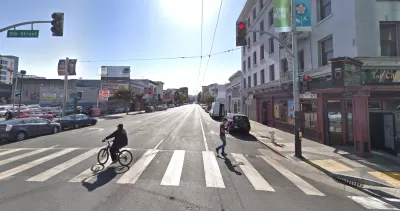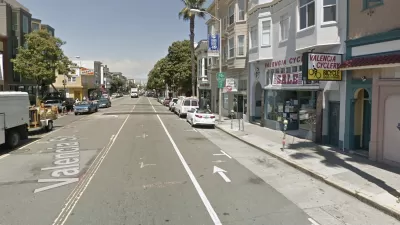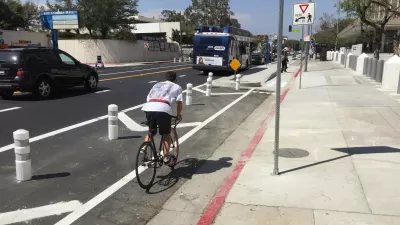On March 8, 30-year-old Tess Rothstein of Berkeley was riding a rented Ford GoBike in San Francisco's SoMa district when a car door suddenly opened, forcing her outside the narrow white line of the conventional bike lane into the path of a truck.

"Rothstein died just across the street from a 'protected' bike lane with a barrier between car traffic and bicycles, which many advocates said would have saved her life," reports Joe Fitzgerald Rodriguez for the San Francisco Examiner on March 12.
Rothstein was riding [on the Howard Street bike lane] between Fifth and Sixth streets when, according to a witness account, a driver-side door from a parked car swung open, prompting Rothstein to swerve into the street where a truck crushed her.
The San Francisco Municipal Transportation Agency, which designs The City’s streets, told the San Francisco Examiner Monday afternoon it would “immediately” remove parking on the north side of Howard Street between Fourth and Sixth streets to create “more space and protection between cars and cyclists.” [See Examiner photo of crash scene – bike lane adjacent to parked motor vehicles.]
The reason for the rapid dispatch of SFMTA workers, known as a Rapid Response Team, "that goes out to sites of traffic-related fatalities and identifies immediate improvements at the intersections or corridors," originated with former Mayor Ed Lee, reported Rodriguez in November 2017. Mayor London Breed added to the empowerment of the teams with a September 26, 2018 directive to expedite implementation of Vision Zero street safety projects planned for high-injury corridors.
The San Francisco Bicycle Coalition observed Rothstein's death marks the first bike fatality of 2019. They asked the city government to take the following actions on Howard Street, a high-injury corridor, "to prevent further loss of life:"
- Extend the existing protected bike lane to 5th Street, including a dedicated bicycle signal at 6th.
- Accelerate approvals of the Folsom and Howard Streetscape project to April.
- Replace all existing mixing zones on Howard from 6th to 11th with signal protected intersections.
"This crash at 6th and Howard was less than a hundred feet away from a protected bike lane that would have saved [Tess Rothstein's] life," notes their March 8 press release. "Where infrastructure stops, people die."
The SFMTA is listening, notes Fitzgerald. "The agency is also moving to implement a 'temporary' protected bike lane on Howard Street, also between Fourth and Sixth streets.
“We are doing an immediate rapid design process and will have it on the street in April,” SFMTA spokesperson Paul Rose said. Additional temporary barriers between Third and Fourth streets are planned after nearby construction is complete, Rose added.
"The sudden swift action encouraged Jodie Medeiros, executive director of the pedestrian advocacy group WalkSF," reports Rachel Swan for the San Francisco Chronicle.
“This is great,” she said. “Look what SFMTA is capable of when they want to be. I expect to see this level of immediacy on all our deadly streets.”
This is not the first time that SMTA has removed on-street parking to create protected bike lanes on high-injury corridors, although this may be the first time it was done so rapidly.
The presence of streetcar tracks and double-parked motor vehicles on the popular 17th Street bike lane in the Mission District has cause numerous bike crashes. After a formal planning process began in June 2017 and the neighborhood showed support for the project, removal of parking on one block was approved to construct protected bike lanes in both directions, protecting cyclists not only from the adjacent motor vehicle traffic but the dangerous streetcar tracks as well.
Roger Rudick, the editor of Streetsblog SF, reported on the positive results on Oct. 18, 2018.
“This kind of physical barrier is precisely the standard we want to keep people biking safely separated from people driving,” wrote Rachel Dearborn, Interim Communications Director for the San Francisco Bicycle Coalition. “We look forward to seeing more of this type of safety improvement applied to high injury corridors across the city.”
Related in Planetizen: Dooring posts
-
Should Car Safety Technology Protect Bikers and Pedestrians Too? February 19, 2015,
-
A Buffer is Better, August 1, 2014What's the best street design to keep bicyclists safely out of the door zone? A buffered bike lane beats a conventional bike lane or "wide curb lane" according to a recent study published in TRB, based on observations in Chicago and Cambridge, Mass.
And SoMa bike fatalities:
-
Third S.F. Cyclist Death Sparks Movement For Protected Bike Lane, September 8, 2013The death of 24-year-old cyclist Amelie Le Moullac on August 14 marks the third this year by a truck, and the second by one turning right (known as a right hook) into the bike lane. Her death has set off a movement for safer streets in SoMa, S.F.
FULL STORY: SF will remove parking along Howard Street where cyclist died to improve street safety

Study: Maui’s Plan to Convert Vacation Rentals to Long-Term Housing Could Cause Nearly $1 Billion Economic Loss
The plan would reduce visitor accommodation by 25,% resulting in 1,900 jobs lost.

North Texas Transit Leaders Tout Benefits of TOD for Growing Region
At a summit focused on transit-oriented development, policymakers discussed how North Texas’ expanded light rail system can serve as a tool for economic growth.

Why Should We Subsidize Public Transportation?
Many public transit agencies face financial stress due to rising costs, declining fare revenue, and declining subsidies. Transit advocates must provide a strong business case for increasing public transit funding.

Invasive Insect Threatens Minnesota’s Ash Forests
The Emerald Ash Borer is a rapidly spreading invasive pest threatening Minnesota’s ash trees, and homeowners are encouraged to plant diverse replacement species, avoid moving ash firewood, and monitor for signs of infestation.

Agreement Keeps NYC Congestion Pricing Alive Through Summer
The tolling program will continue while a court considers the city’s lawsuit against the Trump administration.

Private Donations Propel Early Restoration of Palisades Playground
Los Angeles has secured over $1.3 million in private funding to restore the Pacific Palisades playground months ahead of schedule, creating a modern, accessible space that supports community healing after recent wildfires.
Urban Design for Planners 1: Software Tools
This six-course series explores essential urban design concepts using open source software and equips planners with the tools they need to participate fully in the urban design process.
Planning for Universal Design
Learn the tools for implementing Universal Design in planning regulations.
Ascent Environmental
Borough of Carlisle
Institute for Housing and Urban Development Studies (IHS)
City of Grandview
Harvard GSD Executive Education
Toledo-Lucas County Plan Commissions
Salt Lake City
NYU Wagner Graduate School of Public Service





























